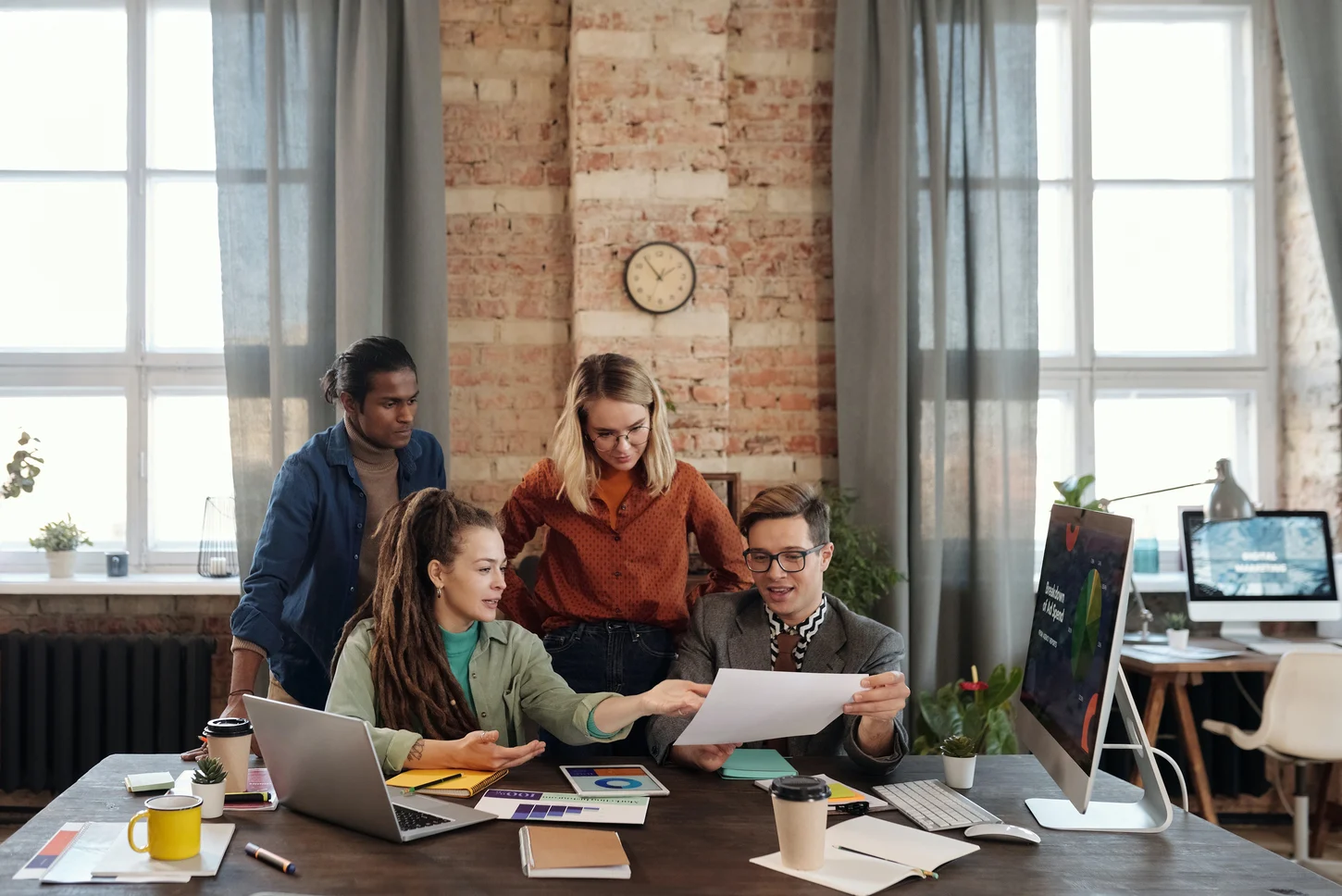
(Source)
In today’s competitive digital landscape, website promotion on Google is essential for boosting visibility and traffic. Google is the most popular search network in the world (91+% this year). All other search networks – Bing, Yahoo, Baidu – account for less than 10% of the total search traffic, except for certain regions. That is why website promotion on Google is the main way to increase the number of visitors.
Advantages of Website Promotion on Google
The popularity, proprietary tools and algorithms of this search engine give sites many opportunities:
- A large audience. On average, google processes 3.5 billion search queries daily, while almost half of that are local searches (users looking for local information).
- Traffic quality. A search engine shows websites for a specific search query. This means that your site will be seen by rather interested users.
- Scaling and localization create opportunities for effective promotion for both large international companies and local businesses.
- Flexibility and a wide range of tools for different strategies and budgets.
- Increased brand awareness due to the reach.
Disadvantages include:
- the length and resource-intensive nature of the process;
- website promotion in the search network requires constant targeted actions.
How to promote a website on Google?
All methods of website promotion using the search engine can be divided into two large groups:
- Organic – conditionally free, when money is invested in improving your own site.
- Paid – those are various types of advertising.
Advertising gives a quick result – ads appear almost immediately after completing the setup. Such advertising is launched with the help of Google Ads. The main disadvantage of it is a time-limited effect. You pay for each click on an ad or display of an ad depending on the selected settings. Once the advertising campaign is terminated, potential customers will not be able to see your site in the ad unit. For effective website promotion on Google, businesses need to focus on both SEO and paid strategies.
Paid advertising and a site’s position on the SERP are not related. The desired top position can be achieved by applying various methods that focus on search engine optimization of a website promotion, both external and internal.
SEO for Google Search promotion
The promotion of the site in the search network is carried out on the basis of ranking factors. They are technical (loading speed, adaptation for mobile devices, etc.), host (domain zone, availability of security certificates), commercial (important for e-commerce – ease of purchase), reference (mentions of the website on the Internet), behavioral (user actions on the site), textual and many others. You can influence the ranking factors by improving the characteristics of the website promotion. I’ll tell you more about each method below.
Link building
It’s the basis of external promotion in search networks, a strategy for planning and placing backlinks to a website on other sites on the Internet. SEO-specialists rightly consider the quantity and quality of links as an important ranking factor.
Successful link building requires:
- Successfully selected donor sites – web resources where links are placed.
- Relevant content – the text should correspond to the topics of both sites and be interesting to users.
- Correctly built links – anchored (the link is embedded in the keyword), indexed (without “nofollow” tag) and without expiration date.
Link building experts use different strategies to build links:
- Outreach – independently searching and contacting each donor site owner directly. Links are placed in guest publications, informational materials, news articles, etc.
- Crowd-marketing – publication of links on forums, in comments, social networks in the form of native advertising – recommendation of goods, participation in discussions, etc.
- Purchase links on specialized exchanges.
Competently built up links not only affect the ranking in the search network, but also contribute to the increase in organic traffic.
Loading Speed
This is the time it takes for a website to fully load in the browser. 2-3 seconds, optimally. Slow loading increases the bounce rate – some users will just search for another, faster website.
You can check the speed on various services, for example, PageSpeed Insight, Pingdom, Dotcom-tools. If you are not satisfied with the result of the test, I recommend several ways to speed up your site:
- Optimize content – reduce images that are too large, move videos to an external platform, such as YouTube.
- Enable caching – some data, such as images, is stored in the browser’s memory and automatically loaded the next time you open it.
- Check the code – remove unnecessary elements and obsolete plugins, adjust the loading priority.
- Remove unnecessary redirect chains.
- Choose hosting according to your site traffic.
Yet, loading speed is an important, but not the only technical factor for website promotion in search engines.
Optimize the mobile version
About 3/5 of all the traffic is mobile. If your site doesn’t have a convenient mobile version, you will lose about 1/2 of potential visitors. This in turn will directly affect the ranking of the site.
I recommend using the “Mobile comes first” principle – initially create a version for the smallest screen with subsequent scaling. To implement this principle develop adaptive design or a separate mobile version on a subdomain.
When developing and optimizing the mobile version keep these things in mind:
- Adaptive design – all elements change proportionally to the screen.
- Vertical scrolling – the website should fit fully width-wise regardless of device size.
- Exclude elements that are not supported by phones.
- Use a readable font. Please.
- Adequate spacing between buttons and links is key to avoid accidental mis-clicking.
Semantics
Semantic core of a website is a set of words and word combinations (keys) that characterize the site (its type of activity, goods, services) and correspond to search queries.
When adding keys, it is important to consider their relevance and frequency. It is also recommended to use long keys of 3-4 words, which contain additional characteristics of your products or regional reference. You can collect keywords and phrases using Keyword Tool, Serpstat and others.
Content optimization
High-quality and interesting content is a key factor in promoting a website in search. Especially after Google’s March 2025 update. The text content of a website should not just match the search queries, but fulfill the real needs of users.
To improve your standing with the help of texts, follow these tips:
- Use headings and subheadings H1, H2, etc. Distribute materials into small semantic blocks.
- Add lists – this makes the text easier to read.
- Use the principles of LSI-copywriting – rely not only on the keys, but also on synonyms and other phrases that are used together with the keys in accordance with your topic.
- Indicate the authorship of the article, which confirms expertise.
- Create an opportunity to comment on your texts – Google likes UGC (user-generated content) and gives it a ranking advantage.
- Use video content more actively. It can be product reviews or testimonials, tutorials, expert tips and advice, company stories, etc.
Micro-markup
Structured texts are easier to read (for people) and understand (for algos). Improving the perception of the page by bots is possible with the help of markup tags and attributes.
This is called micro-markup. With its help you will be able to:
- Improve the snippet (display of the site on the search results page) – by adding a keyword or short answer to a search query.
- Set an image or video that users will see on the search results page.
- Use breadcrumbs – a chain that shows the fastest path of the user from the main page to the current one.
Behavioral factors
With each algorithm update, the search engine gives more and more weight to behavioral factors. Analyze them by such indicators:
- CTR of the snippet (the ratio of website sightings on the results page to the number of clicks) and response satisfaction (whether the user continued further search).
- Website traffic.
- Time spent on the website.
- Browsing and scroll depth.
- Interaction – abandonments, conversions.
Improving these indicators is totally possible by:
- optimizing technical specifications;
- writing useful and interesting content;
- UX design.
Local search
Google’s algorithms take local businesses into account when displaying search results, trying to choose the closest match for a person. This is primarily relevant for stores, cafes, and hotels.
These are some of the ways to improve local search:
- Choose the right domain zone.
- Develop a Google Business Profile – GBP (formerly Google My Business). Provide information, add photos, respond to comments.
- Promote through social networks and link the company’s Facebook, Instagram, LinkedIn, Pinterest, TikTok, X accounts to GBP.
- Add geo-referenced keys to the semantic core, for example “buy new car Brooklyn”.
- Get listed in catalogs, aggregators and directories.
Implementing inclusivity
Inclusivity is the accessibility of website features to different categories of customers, which will bring more visits and sales in the long run.
Inclusive web design is based on principles such as:
- Content optimization – structured, understandable, readable.
- Logical hierarchy of the website, quick access to the shopping cart and other important sections.
- Implementation of voice playback of content.
HTTPS
It’s a secure data transfer protocol. With the regular HTTP protocol, a browser can open websites and display them on the user’s screen. HTTPS has the same principle of operation, but it protects user data. This is accomplished by attaching an SSL security certificate.
Most browsers warn users about the unreliability of the connection and automatically do not display some sites. This increases the number of bounce rates and negatively affects their ranking.
The main requirements of website promotion
The search engine is paying more and more attention to useful content and reader convenience every year.
Recently, the INP metric has become the primary Search Console tool for Core Web Vitals. Interaction to Next Paint shows how a web page reacts when a user clicks a button or navigates to a specific section. Google now explicitly states that it will use these Vitals when ranking sites.
Also, Google will give priority to smaller and independant websites with original content. Even back in March, during previous large updates, Google experts noted the importance of promoting original content.
What prevents a website from moving up in search?
There are many factors that prevent you from getting a positive result when promoting a website. Let’s consider the main ones:
- New websites are promoted more slowly. But a successful SEO-strategy will allow you to get the desired result.
- Technical errors.
- Ignoring commercial factors.
- Incorrect key distribution, which leads to an increase in bounce rates. Potential customers led to some unnecessary pages.
Often it is hard to get a stable result due to the lack of SEO-strategy. Chaotic actions and improvement of individual parameters give a short-term and insignificant effect. In the worst case, irrational activity can lead to issues with the search engine.
Conclusion
Effective website promotion on Google requires attention to various factors, including content quality, user behavior, and technical performance. By implementing the right SEO strategies and staying updated with Google’s algorithm changes, you can boost your site’s rankings and drive more traffic in 2025.

Vitalii Nedzelenko is a marketing manager at Good Zone Service & Repairs, a Brooklyn based store specialized in repairing Apple devices. He is passionate about technology, gadgets, and digital marketing.